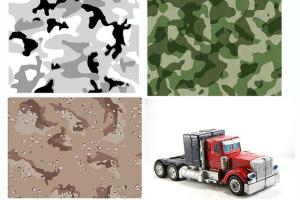Mastering the Art of Camouflage Paint: A Comprehensive Guide

-
Quick Links:
- Introduction
- Understanding Camouflage Paint
- Types of Camouflage Paint
- Preparation Steps for Camouflage Painting
- Designing Your Pattern
- Application Techniques
- Case Studies
- Expert Insights
- FAQs
- Conclusion
Introduction
Camouflage painting is not just for military use—it has found its way into various domains such as home decor, arts and crafts, and even automotive applications. This guide will explore everything you need to know about camouflage paint, from understanding its characteristics to executing a successful camouflage paint job. Whether you're looking to enhance your tactical gear, revamp your living space, or create artwork, this guide will provide you with the necessary techniques and insights.
Understanding Camouflage Paint
Camouflage paint is designed to conceal objects within their environment. It employs a mix of colors, patterns, and finishes that can disrupt the outline of the object being painted. The primary purpose is to blend into the surroundings, making it harder to detect.
- Color Theory: Understanding how colors interact with each other is crucial for effective camouflage.
- Pattern Types: Different patterns serve various environments—urban, woodland, desert, etc.
Types of Camouflage Paint
There are several types of camouflage paint available, each suited for different applications:
- Military Camouflage: Generally consists of earth tones and is used for tactical gear.
- Home Decor Camouflage: Often lighter colors and more artistic patterns for aesthetic purposes.
- Vehicle Camouflage: Designed to withstand weather and harsh conditions while providing concealment.
- Artistic Camouflage: Used in creative projects, often incorporating vibrant colors.
Preparation Steps for Camouflage Painting
Proper preparation is essential for achieving the best results. Follow these steps:
- Choose Your Object: Decide what you will be painting—gear, furniture, etc.
- Clean the Surface: Ensure the surface is free from dust and grease.
- Sand the Surface: For better adhesion, lightly sand the surface if necessary.
- Prime the Surface: Depending on the object, a primer may be needed.
Designing Your Pattern
Designing an effective camouflage pattern involves understanding the environment where the object will be used. Here’s how to do it:
- Research Local Environments: Study the colors and patterns that are common in your area.
- Sketch Ideas: Before applying paint, sketch various designs to see what works best.
- Choose Your Colors: Select colors that complement the environment.
Application Techniques
Applying camouflage paint can be done in several ways:
- Spray Painting: Best for large surfaces, providing even application.
- Brush Techniques: Ideal for detailed work and smaller areas.
- Sponge Technique: Useful for creating textures and layering colors.
Step-by-Step Application Guide
- Base Coat: Apply the first layer of paint in your base color.
- Layering: Use additional colors to create patterns, allowing each layer to dry before adding the next.
- Final Touches: Add any necessary details or texturing effects.
Case Studies
To better understand the application of camouflage paint, let’s look at a few case studies:
Case Study 1: Military Gear
A military unit utilized a custom camouflage pattern that blended with their operational environment. The gear's performance exceeded expectations, leading to a significant reduction in detection rates.
Case Study 2: Home Decor
A homeowner transformed their garden shed using camouflage paint. The project not only improved aesthetics but also helped the shed blend into its surroundings, enhancing the overall look of the garden.
Expert Insights
We reached out to professional painters and camouflage experts for their insights:
"The key to effective camouflage is understanding the environment and using colors that disrupt outline and shape." - Jane Doe, Camouflage Specialist
FAQs
- 1. What is the best type of paint for camouflage?
- Water-based acrylic paints are often recommended for their ease of use and versatility.
- 2. Can I use spray paint for camouflage?
- Yes, spray paint is effective for achieving an even application on larger surfaces.
- 3. How do I clean surfaces before painting?
- Use soap and water, followed by a rinse and drying to ensure the surface is clean.
- 4. What colors should I use for woodland camouflage?
- Earth tones such as greens, browns, and blacks work well in wooded environments.
- 5. Is primer necessary for camouflage paint?
- It depends on the surface; a primer can improve adhesion and durability.
- 6. How long does camouflage paint last?
- Durability varies, but quality paint can last several years with proper care.
- 7. Can I mix different types of paint?
- Mixing paint types is generally not recommended as it can affect adhesion and finish.
- 8. How do I create a custom camouflage pattern?
- Start by researching local environments, then sketch your designs before applying them.
- 9. Can I use camouflage paint indoors?
- Yes, but choose lighter colors and patterns for a more aesthetic look.
- 10. What are some common mistakes to avoid?
- Avoid using too many colors, ensure proper surface preparation, and let layers dry between applications.
Conclusion
Camouflage painting can be a rewarding project, whether for practical applications or creative endeavors. By understanding the principles of camouflage, designing effective patterns, and employing the right techniques, anyone can master the art of camouflage paint. With practice and creativity, you can create stunning results that blend seamlessly into any environment.
Random Reads
- How to get help with kindle services
- How to build a straw bale house
- Simple ways to get a fake number for whatsapp
- Create user defined function excel
- Create two networks from one connection
- How to replace dead batteries in apple magic mouse
- How to use operating system from usb stick
- How to convert excel to powerpoint
- How to convert file to pdf
- 7 easy ways to download youtube videos